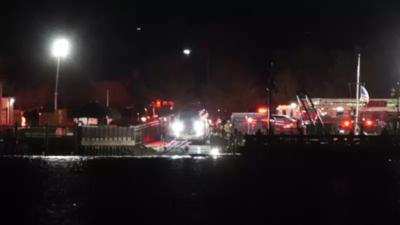- News
- World News
- US News
- Old technology at Reagan airport could be factor in DC collision: Captain Sullenberger
Trending
Old technology at Reagan airport could be factor in DC collision: Captain Sullenberger
Captain Sullenberger, known for his 'Hudson Miracle,' speculates that night-time conditions might have affected the recent collision between an American Airlines plane and a US Army helicopter over Washington, D.C.'s Potomac River. The incident at the outdated Ronald Reagan Airport resulted in fatalities, highlighting the continuous need for vigilance and advancements in aviation safety.
Captain Chesley Sullenberger, known for his successful Hudson River aircraft landing 15 years ago, suggests that night-time water operations might have influenced the collision between an American Airlines aircraft and a US Army helicopter in Washington, DC on Wednesday night.
The collision involved two aircraft carrying 67 people collectively and marks the first commercial airline fatality in the United States in nearly 16 years.
"There would have been fewer ground lights visible over the water than over land at night," which "might have made it a little bit harder to see. But that's supposition. We don't know," he said while speaking to the New York Times.
He highlighted the challenges of aviation at night, particularly regarding aircraft identification, stating, "Everything is harder at night," because "basically all you can see is the lights on them."
Sullenberger also highlighted concerns about dated infrastructure at Ronald Reagan Washington National Airport, the intended destination of American Eagle Flight 5342 before it collided with a US Army Black Hawk helicopter and crashed into the Potomac River near central Washington.
The airport, constructed in the 1930s, presents unique challenges with its compact runways and high traffic volume, requiring specialised pilot training. "It hasn't changed much since then. Of course, we've added technology to it. But a lot of the technology is old," he said.
Sullenberger successfully made an emergency landing on the Hudson River when his Airbus A320's engines failed following a bird strike during takeoff from New York's LaGuardia Airport in January 2009. All 155 passengers were safely rescued.
Following this incident, Sullenberger became an active advocate for air safety and served a term as US ambassador to the International Civil Aviation Organization.
Sullenberger highlighted that Thursday crash demonstrates the importance of maintaining vigilance in accident investigation and prevention.
"We've had to learn important lessons literally with blood too often, and we had finally gotten beyond that, to where we could learn from incidents, and not accidents," he said.
End of Article
FOLLOW US ON SOCIAL MEDIA
Visual Stories
Hot Picks
TOP TRENDING
Explore Every Corner
Across The Globe












